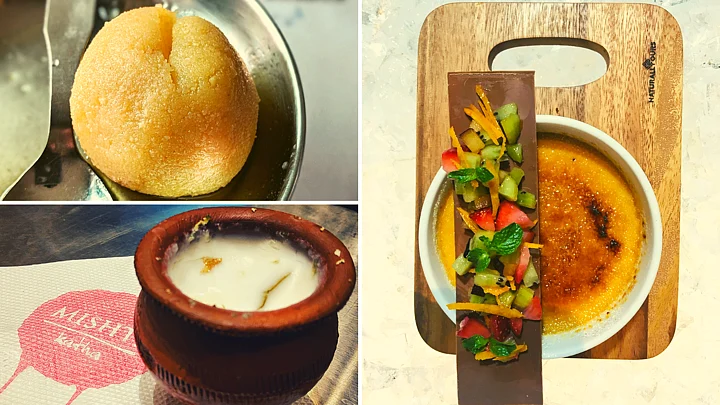It’s 6 am and there’s an infectious energy at Victoria Memorial on a cold January morning. Kolkata’s most recognisable landmark is also a magnet for the city’s fitness conscious, who are undeterred by the temperature. Although I had my trainers on, I was there solely to capture the iconic sunrise image of what locals refer to as VM.
At that very moment, somewhere in North Bengal, a tapper would be checking in on his pot of Nolen Gur.
Kolkata’s brief winter spell (from the second half of December to the first half of February) is my favourite time to visit the city. It’s not just the magic of Christmas in December (this is one of the cities where you can feel the spirit of Christmas aka Bada Din in the air) or the pleasant winter – but it’s also Nolen Gur Season. That time of the year when sweet shops and creative chefs across the city are busy crafting signature sweets with their favourite ingredient.
Nolen Gur translates to new jaggery and it is extracted from date palm trees using deft skills as the mercury drops during the winter months in West Bengal.
A cloudy morning meant that I didn’t get the perfect ochre glow at sunrise but that didn’t ruin my picture. I made a quick stopover at Kona Dukan near the Calcutta Stock Exchange. Once a busy spot for brokers, this street is teeming with tiny toast (the Malai toast is legendary) and tea shops.
After walking through North Kolkata’s busy and winding streets and making stops at some legendary 19th century homes, I finally arrived at Putiram in the College Square area for a late breakfast. Their luchi and aloo dum might be their bestseller but it was their Nolen Gur Rosogolla that had my attention.
Almost every single sweet shop has a line-up of Nolen Gur specialties for the winter. Unlike refined sugar, Nolen Gur lends a mellow sweetness and a mild smoky aroma. Once I’d polished off their brown Rosogolla and made a quick stop at India Coffee House – this establishment always evokes nostalgia for Kolkatans – I arrived in Bhowanipur at a sweet shop with a 134-year old legacy.
Balaram Mullick and Rajaram Mullick (or just BRM) probably stocks more Nolen Gur specialties than most sweet stores. What’s more, you can buy Nolen Gur in blocks or a convenient liquid form – just drizzle it over ice cream or hot phulkas (that’s one of my many ideas of comfort food).
This store mixes up traditional favourites like the Jhol Bhora Sondesh (where liquid Nolen Gur is cleverly concealed inside the classic Nolen Gur Sondesh) and its own modern innovations like a Nolen Gur baked Mishti Doi. But nothing quite came close to their Nolen Gur Cham Cham that is a refreshing change from the cloyingly sweet conventional version.
It’s not just traditional sweet shops in old Kolkata that hold sway. I moved to the city’s new Tech and Business hub, Rajarhat, by evening and my first pit-stop was the Novotel Kolkata where the culinary team has crafted a clever Nolen Gur Crème brûlée that adds a Bengali twist to a French Classic.
My last stop was the spanking new Bangla Mishti hub in the New Town area that rounds up some of the city’s iconic sweet shops in a plush setting. Think of it as a food court of sweet shops, a spot where you will experience that ‘kid in a candy store moment’ many times over. My first moment came first at Nalin Chandra Das where I sunk my teeth into their seasonal specialty. The Monohora is a Sondesh encased in Nolen Gur and might pass off for a gourmet chocolate from a distance.
In a city where change doesn’t always come easy (and that’s not an entirely bad thing), Mishti Kotha, a new-age sweet shop has revolutionised the presentation of Bengali Mishti. It wasn’t one of their ‘Instagramable’ sweets that had my attention but their clever Gondhoraj Mishti Doi. The Gondhoraj lemon (and the leaves) is treasured in kitchens across Bengal for its unique flavour and is also available in the monsoon and winter seasons.
The Nolen Gur season isn’t just a showcase for traditional sweets but is evidence that traditional sweet shops are not shying away from innovating and stepping out of their comfort zones. After all, if their forefathers were not open to experimentation, they wouldn’t have reimagined a Portuguese soft cheese as Chhana (the quintessential Bengali sweet ingredient) back in the 17th century. We wouldn’t have half the Bengali sweets of today but for that interesting twist.
That’s almost unthinkable for a true blue Bengali Mishti fan like myself.
Stay: The all-new Ibis Kolkata Rajarhat (www.accorhotels.com) is one of the closest hotels to the Bangla Mishti hub.
Good to know: It’s possible to cover all major sweet shops in one day or over a weekend. The Nolen Gur specialties will be available till early March.
(Ashwin Rajagopalan enjoys communicating across boundaries in his three distinct roles as a widely published lifestyle writer, a consultant and one of India’s only cross cultural trainers. Ashwin writes extensively on travel, food, technology and trends.)
(At The Quint, we question everything. Play an active role in shaping our journalism by becoming a member today.)
